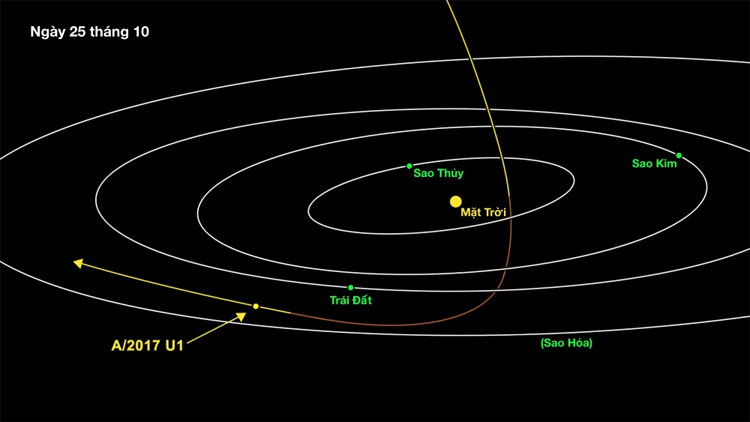For the first time, identify an object from outside the Solar System
Scientists have for the first time identified a guest from the interstellar space outside the Solar System. This celestial body is identified by Pan-STARRS 1 telescope researchers in Hawaii.
For decades, sky observers have been constantly searching for thousands of new celestial bodies, but they all have a starting point somewhere in the Solar System. Even the most distant bodies are located in the Kuiper Belt or further the Oort Cloud, where the Solar System boundary.
But this celestial body is identified as A / 2017 U1 is a very new thing, it has an extremely large orbit, its hyperbolic orbit does not seem to be bound by the Sun. According to the first observational data of the Asteroid Center of the International Astronomical Society, it is very likely that a celestial body "escapes" from another star.

Location of A / 2017 U1 on October 25 after it cuts the zodiacal plane and reaches the near-Japanese point in September.(Photo: NASA / JPL).
'We have been waiting for this for decades. There are always theories about this object, asteroids or comets that belong to another planetary system, and for some reason leave the "homeland" and wander inside their Solar System. Paul Chodas from NASA's Center for Near-Earth Celestial Studies, said.
When A / 2017 U1 was discovered for the first time, scientists said that it was a comet so it was originally identified as C / 2017 U1 (C is comet, comet) . But subsequent observations showed that there were no surrounding clouds of gas, so it was renamed A as asteroid, asteroid.
Based on initial observations, scientists said the object was no larger than 400 meters, beginning to appear in the sky in the constellation Lyra. A / 2017 U1 moves in space at speeds of up to 92,000km per hour.
The trajectory of A / 2017 U1 is almost perpendicular to the zodiacal plane - the plane that is flat with the orbit of the Earth and the planets in the Solar System. The celestial body crosses this plane on September 2 in the area inside Mercury's orbit.

Photo A / 2017 U1 was taken by the Tenagra Observatory in Rio Rico, Arizona on October 21 last.The total shooting time is 9 minutes, each frame is 3 minutes wide in the sky.(Photos: Paulo Holvorcem & Michael Schwartz).
A week later, on September 9, the object was 37.6 million kilometers from the Sun and reached a near-daily point - the closest point to the Sun. With a level 20 visible brightness, very faint but astronomers still observed and estimated that it is about 160 meters wide with 10% sunlight reflection.
A / 2017 U1 is closest to Earth on October 14, at a distance of 24 million km - 60 times the distance from Earth to the Moon. The object is currently above the zodiacal plane and moves in the direction of leaving the Solar System at speeds of up to 156,400 km / hr, towards the constellation Pegasus.
Although early observations show that it is an astronomical object from interstellar space, much more data and other evidence is needed to accurately confirm this. Astronomers are taking advantage of observing and studying the A / 2017 U1 with many advanced telescopes before it goes away and disappears from our sight forever.
- Discovering the undiscovered '10th Planet' in the Solar System?
- Pioneer 10 - the mission of the pioneer
- Discover the most distant object in the Solar System
- Time on Earth floated faster than in the universe
- Mysteriously the giant wall of the solar system was discovered by NASA
- 'The rebel' goes against the whole solar system
- Discover the oldest solar system outside the solar system
- Does the solar system have the 9th planet to own oceans and life?
- Beautiful photo from the Solar System
- The second interstellar travel object to the Solar System
- It is the first time to observe the aurora outside the Solar System
- Evidence of the first moon outside the solar system
 Van Allen's belt and evidence that the Apollo 11 mission to the Moon was myth
Van Allen's belt and evidence that the Apollo 11 mission to the Moon was myth The levels of civilization in the universe (Kardashev scale)
The levels of civilization in the universe (Kardashev scale) Today Mars, the sun and the Earth are aligned
Today Mars, the sun and the Earth are aligned The Amazon owner announced a secret plan to build a space base for thousands of people
The Amazon owner announced a secret plan to build a space base for thousands of people